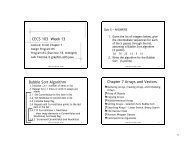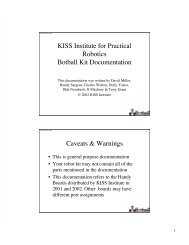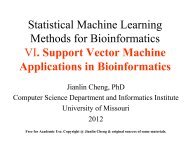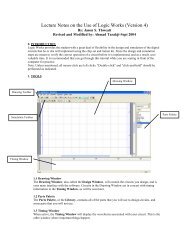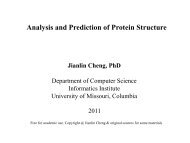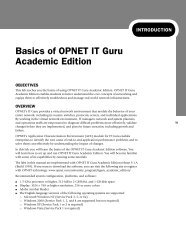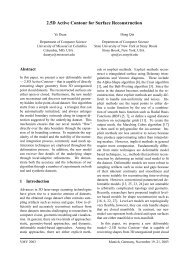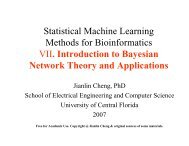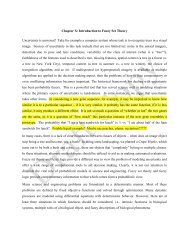Machine Learning Methods for Protein Structure ... - ResearchGate
Machine Learning Methods for Protein Structure ... - ResearchGate
Machine Learning Methods for Protein Structure ... - ResearchGate
You also want an ePaper? Increase the reach of your titles
YUMPU automatically turns print PDFs into web optimized ePapers that Google loves.
48 IEEE REVIEWS IN BIOMEDICAL ENGINEERING, VOL. 1, 2008<br />
[46] A. Krogh, B. Larsson, G. von Heijne, and E. L. L. Sonnhammer, “Predicting<br />
transmembrane protein topology with a hidden Markov model:<br />
Application to complete genomes,” J. Mol. Biol., vol. 305, no. 3, pp.<br />
567–580, 2001.<br />
[47] P. Y. Chou and G. D. Fasman, “Prediction of the secondary structure<br />
of proteins from their amino acid sequence,” Adv. Enzymol., vol. 47,<br />
pp. 45–148, 1978.<br />
[48] N. Qian and T. J. Sejnowski, “Predicting the secondary structure of<br />
globular proteins using neural network models,” J. Mol. Biol., vol. 202,<br />
pp. 265–884, 1988.<br />
[49] P. Baldi, S. Brunak, P. Frasconi, G. Soda, and G. Pollastri, “Exploiting<br />
the past and the future in protein secondary structure prediction,” Bioin<strong>for</strong>matics,<br />
vol. 15, no. 11, pp. 937–946, 1999.<br />
[50] I. P. Craw<strong>for</strong>d, T. Niermann, and K. Kirchner, “Prediction of secondary<br />
structure by evolutionary comparison: Application to the a subunit of<br />
tryptophan synthase,” <strong>Protein</strong>s, vol. 2, pp. 118–129, 1987.<br />
[51] G. J. Barton, R. H. Newman, P. S. Freemont, and M. J. Crumpton,<br />
“Amino acid sequence analysis of the annexin supergene family of proteins,”<br />
Eur. J. Biochem., vol. 198, pp. 749–760, 1991.<br />
[52] B. Rost and C. Sander, “Improved prediction of protein secondary<br />
structure by use of sequence profiles and neural networks,” Proc. Nat.<br />
Acad. Sci., vol. 90, pp. 7558–7562, 1993.<br />
[53] A. Bairoch, R. Apweiler, C. H. Wu, W. C. Barker, B. Boeckmann, S.<br />
Ferro, E. Gasteiger, H. Huang, R. Lopez, M. Magrane, M. J. Martin, D.<br />
A. Natale, C. O’Donovan, N. Redaschi, and L. S. Yeh, “The universal<br />
protein resource (UniProt),” Nucleic Acids Res., vol. 33, pp. D154–159,<br />
2005.<br />
[54] S. F. Altschul, T. L. Madden, A. A. Scha_er, J. Zhang, Z. Zhang, W.<br />
Miller, and D. J. Lipman, “Gapped BLAST and PSI-BLAST: A new<br />
generation of protein database search programs,” Nuc. As. Res., vol.<br />
25, no. 17, pp. 3389–3402, 1997.<br />
[55] G. Pollastri and A. McLysaght, “Porter: A new, accurate server <strong>for</strong><br />
protein secondary structure prediction,” Bioinfo., vol. 21, no. 8, pp.<br />
1719–20, 2005.<br />
[56] J. Cheng, A. Z. Randall, M. J. Sweredoski, and P. Baldi, “SCRATCH:<br />
A protein structure and structural feature prediction server,” Nuc. As.<br />
Res., vol. 33, pp. 72–76, 2005.<br />
[57] R. Bondugula and D. Xu, “MUPRED: A tool <strong>for</strong> bridging the gap between<br />
template based methods and sequence profile based methods <strong>for</strong><br />
protein secondary structure prediction,” <strong>Protein</strong>s, vol. 66, no. 3, pp.<br />
664–670, 2007.<br />
[58] J. J. Ward, L. J. McGuffin, B. F. Buxton, and D. T. Jones, “Secondary<br />
structure prediction using support vector machines,” Bioinfo., vol. 19,<br />
pp. 1650–1655, 2003.<br />
[59] Randall, J. Cheng, M. Sweredoski, and P. Baldi, “TMBpro: Secondary<br />
structure, beta-contact, and tertiary structure prediction of transmembrane<br />
beta-barrel proteins,” Bioinfo., vol. 24, pp. 513–520, 2008.<br />
[60] B. Rost, “Rising accuracy of protein secondary structure prediction,”<br />
in <strong>Protein</strong> <strong>Structure</strong> Determination, Analysis, and Modeling <strong>for</strong> Drug<br />
Discovery, D. Chasman, Ed. New York: Marcel Dekker, 2003, pp.<br />
207–249.<br />
[61] J. Cheng, M. Sweredoski, and P. Baldi, “DOMpro: <strong>Protein</strong> domain<br />
prediction using profiles, secondary structure, relative solvent accessibility,<br />
and recursive neural networks,” Data Mining Knowledge Discovery,<br />
vol. 13, pp. 1–10, 2006.<br />
[62] Y. Freund, “Boosting a weak learning algorithm by majority,” in Proc.<br />
Third Annu. Workshop Computational <strong>Learning</strong> Theory, 1990.<br />
[63] O. Olmea and A. Valencia, “Improving contact predictions by the combination<br />
of correlated mutations and other sources of sequence in<strong>for</strong>mation,”<br />
Fold Des, vol. 2, pp. s25–s32, 1997.<br />
[64] P. Baldi and G. Pollastri, “A machine learning strategy <strong>for</strong> protein analysis,”<br />
IEEE Intelligent Systems, Special Issue Intelligent Systems in Biology,<br />
vol. 17, no. 2, pp. 28–35, Feb. 2002.<br />
[65] A. Aszodi, M. Gradwell, and W. Taylor, “Global fold determination<br />
from a small number of distance restraints,” J. Mol. Biol., vol. 251, pp.<br />
308–326, 1995.<br />
[66] M. Vendruscolo, E. Kussell, and E. Domany, “Recovery of protein<br />
structure from contact maps,” Folding Design, vol. 2, pp. 295–306,<br />
1997.<br />
[67] J. Skolnick, A. Kolinski, and A. Ortiz, “MONSSTER: A method <strong>for</strong><br />
folding globular proteins with a small number of distance restraints,” J<br />
Mol. Biol., vol. 265, pp. 217–241, 1997.<br />
[68] K. Plaxco, K. Simons, and D. Baker, “Contact order, transition state<br />
placement and the refolding rates of single domain proteins,” J. Mol.<br />
Biol., vol. 277, pp. 985–994, 1998.<br />
[69] M. Punta and B. Rost, “<strong>Protein</strong> folding rates estimated from contact<br />
predictions,” J. Mol. Biol., pp. 507–512, 2005a.<br />
[70] P. Baldi and G. Pollastri, “The principled design of large-scale recursive<br />
neural network architectures—DAG-RNNs and the protein<br />
structure prediction problem,” J. <strong>Machine</strong> <strong>Learning</strong> Res., vol. 4, pp.<br />
575–602, 2003.<br />
[71] M. Punta and B. Rost, “PROFcon: Novel prediction of long-range contacts,”<br />
Bioinfo., vol. 21, pp. 2960–2968, 2005b.<br />
[72] G. Shackel<strong>for</strong>d and K. Karplus, “Contact prediction using mutual in<strong>for</strong>mation<br />
and neural nets,” <strong>Protein</strong>s, vol. 69, pp. 159–164, 2007.<br />
[73] R. MacCallum, “Striped sheets and protein contact prediction,”<br />
Bioinfo., vol. 20, no. Supplement 1, pp. i224–i231, 2004.<br />
[74] J. Cheng and P. Baldi, “Improved residue contact prediction using support<br />
vector machines and a large feature set,” BMC Bioin<strong>for</strong>matics, vol.<br />
8, p. 113, 2007.<br />
[75] J. M. G. Izarzugaza, O. Graña, M. L. Tress, A. Valencia, and N. D.<br />
Clarke, “Assessment of intramolecular contact predictions <strong>for</strong> CASP7,”<br />
<strong>Protein</strong>s, vol. 69, pp. 152–158.<br />
[76] S. Wu and Y. Zhang, “A comprehensive assessment of sequence-based<br />
and template-based methods <strong>for</strong> protein contact prediction,” Bioinfo.,<br />
2008, to be published.<br />
[77] J. Cheng and P. Baldi, “Three-stage prediction of protein beta-sheets<br />
by neural networks, alignments, and graph algorithms,” Bioinfo., vol.<br />
21, pp. i75–i84, 2005.<br />
[78] P. Fariselli, P. Riccobelli, and R. Casadio, “Role of evolutionary in<strong>for</strong>mation<br />
in predicting the disulfide-bonding state of cysteine in proteins,”<br />
<strong>Protein</strong>s, vol. 36, pp. 340–346, 1999.<br />
[79] A. Vullo and P. Frasconi, “Disulfide connectivity prediction using recursive<br />
neural networks and evolutionary in<strong>for</strong>mation,” Bioinfo., vol.<br />
20, pp. 653–659, 2004.<br />
[80] J. Cheng, H. Saigo, and P. Baldi, “Large-scale prediction of disulphide<br />
bridges using kernel methods, two-dimensional recursive neural networks,<br />
and weighted graph matching,” <strong>Protein</strong>s: <strong>Structure</strong>, Function,<br />
Bioin<strong>for</strong>matics, vol. 62, no. 3, pp. 617–629, 2006b.<br />
[81] A. Z. Randall, J. Cheng, M. Sweredoski, and P. Baldi, “TMBpro: Secondary<br />
structure, beta-contact, and tertiary structure prediction of transmembrane<br />
beta-barrel proteins,” Bioinfo., vol. 24, pp. 513–520, 2008.<br />
[82] M. Vassura, L. Margara, P. Di Lena, F. Medri, P. Fariselli, and R.<br />
Casadio, “FT-COMAR: Fault tolerant three-dimensional structure<br />
reconstruction from protein contact maps,” Bioinfo., vol. 24, pp.<br />
1313–1315, 2008.<br />
[83] C. A. Rohl and D. Baker, “De novo determination of protein backbone<br />
structure from residual dipolar couplings using Rosetta,” J. Amer.<br />
Chemical Soc., vol. 124, pp. 2723–2729, 2004.<br />
[84] P. M. Bowers, C. E. Strauss, and D. Baker, “De novo protein structure<br />
determination using sparse NMR data,” J. Biomol. NMR, vol. 18, no.<br />
4, pp. 311–318, 2000.<br />
[85] Y. Zhang and J. Skolnick, “Automated structure prediction of weakly<br />
homologous proteins on a genomic scale,” Proc Nat. Acad. Sci., vol.<br />
101, no. 20, pp. 7594–7599, 2004a.<br />
[86] D. T. Jones, “GenTHREADER: An efficient and reliable protein fold<br />
recognition method <strong>for</strong> genomic sequences,” J. Mol. Biol., vol. 287, pp.<br />
797–815, 1999a.<br />
[87] D. Kim, D. Xu, J. Guo, K. Ellrott, and Y. Xu, “PROSPECT II: <strong>Protein</strong><br />
structure prediction method <strong>for</strong> genome-scale applications,” <strong>Protein</strong><br />
Eng., vol. 16, no. 9, pp. 641–650, 2003.<br />
[88] J. Cheng and P. Baldi, “A machine learning in<strong>for</strong>mation retrieval<br />
approach to protein fold recognition,” Bioinfo., vol. 22, no. 12, pp.<br />
1456–1463, 2006.<br />
[89] K. T. Simons, C. Kooperberg, E. Huang, and D. Baker, “Assembly of<br />
protein tertiary structures from fragments with similar local sequences<br />
using simulated annealing and Bayesian scoring functions,” J. Mol.<br />
Biol., vol. 268, pp. 209–225, 1997.<br />
[90] B. Wallner and A. Elofsson, “Prediction of global and local model<br />
quality in CASP7 using Pcons and ProQ,” <strong>Protein</strong>s, vol. 69, pp.<br />
184–193, 2007.<br />
[91] J. Qiu, W. Sheffler, D. Baker, and W. S. Noble, “Ranking predicted<br />
protein structures with support vector regression,” <strong>Protein</strong>s, vol. 71,<br />
pp. 1175–1182, 2007.<br />
[92] K. Karplus, C. Barrett, and R. Hughey, “Hidden Markov models <strong>for</strong><br />
detecting remote protein homologies,” Bioinfo., vol. 14, no. 10, pp.<br />
846–856, 1998.<br />
[93] S. R. Eddy, “Profile hidden Markov models,” Bioinfo., vol. 14, pp.<br />
755–763, 1998.<br />
[94] J. Soeding, “<strong>Protein</strong> homology detection by HMM-HMM comparison,”<br />
Bioinfo., vol. 21, pp. 951–960, 2005.<br />
[95] A. Sali and T. L. Blundell, “Comparative protein modelling by satisfaction<br />
of spatial restraints,” J. Mol. Biol., vol. 234, pp. 779–815, 1993.<br />
[96] Y. Zhang and J. Skolnick, “SPICKER: A clustering approach to identify<br />
near-native protein folds,” J. Comp. Chem., vol. 25, pp. 865–871,<br />
2004b.<br />
[97] D. Cozzetto, A. Kryshtafovych, M. Ceriani, and A. Tramontano, “Assessment<br />
of predictions in the model quality assessment category,” <strong>Protein</strong>s,<br />
vol. 69, no. S8, pp. 175–183, 2007.<br />
[98] P. Aloy, G. Moont, H. A. Gabb, E. Querol, F. X. Aviles, and M. J.<br />
E. Sternberg, “Modelling protein docking using shape complementarity,<br />
electrostatics and biochemical in<strong>for</strong>mation,” <strong>Protein</strong>s, vol. 33,<br />
pp. 535–549, 1998.<br />
[99] A. J. Bordner and A. A. Gorin, “<strong>Protein</strong> docking using surface<br />
matching and supervised machine learning,” <strong>Protein</strong>s, vol. 68, pp.<br />
488–502, 2007.<br />
Authorized licensed use limited to: University of Missouri System. Downloaded on April 8, 2009 at 18:32 from IEEE Xplore. Restrictions apply.



